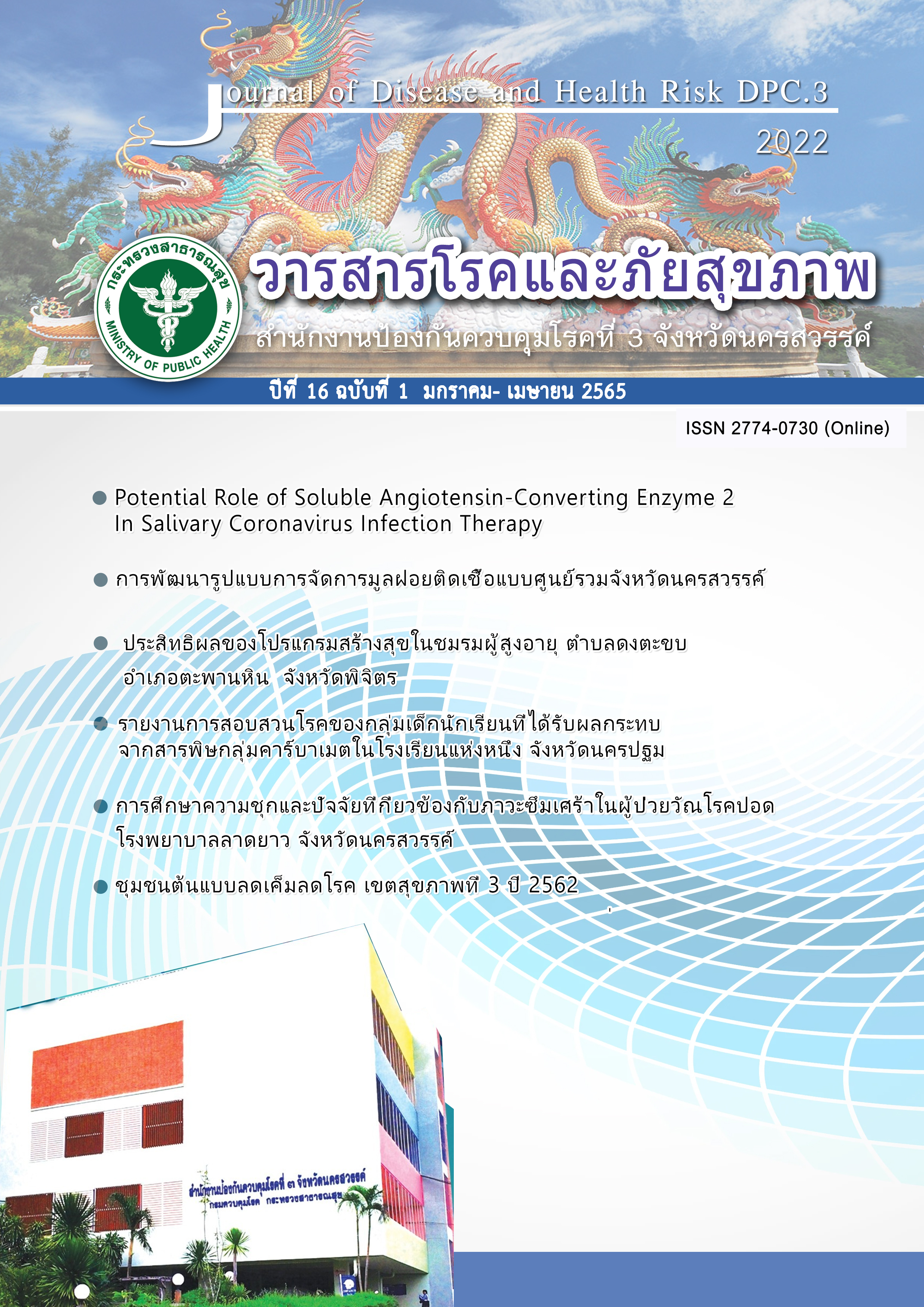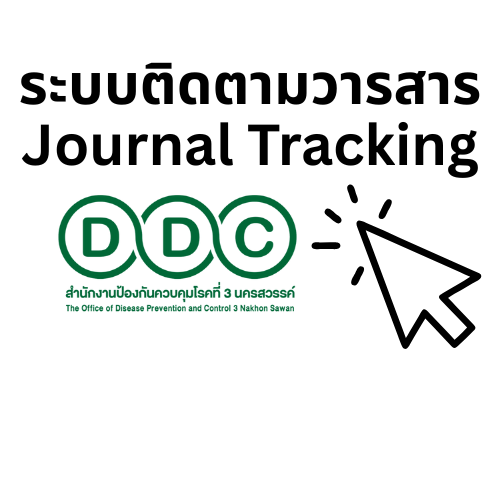The development of a centralized infectious waste management model Nakhonsawan Province
Keywords:
Centralized infectious waste management, District health service networkAbstract
This is actionresearch its objective is to develop a centralized management model of infectious waste inthe District Health Service Network in Nakhon Sawan Province by gathering information on the management of infectious waste in203 hospitals under the Ministry of Public Health at all levels. The development model was set later: a prototype area was selected, followed,and evaluated, each step of data collection was analyzed; the qualitative data by content analysis, the quantitative by descriptive statistics such as frequency distribution, percentage, mean, standard deviation,and independent t-test.The results of the research revealed that Nakhon Sawan Province had a large amount of infectious waste originatingfrom hospitals under the Office of the Permanent Secretary for Public Health. Before the implementation of the fiscal year 2016, the amount of infectious waste was 481.94 tons/year, collected and disposed of by private companies and burned in standardized kilns in Nakhon Sawan and Ayutthaya Provinces. Some of the infected waste was burned in the small incinerators at the Tambon Health Promoting Hospital. The model of infectious waste management of the district health service network before the operation found that there wascentralized management by Sub-district Health Promoting Hospitals, delivering infectious waste to 11 networks, 2 networks, separated and non-centralizeddisposedofafter the fiscal year 2019, the amount of infectious waste was 501.74 tons/year, the average rate was 0.95 kg/bed/day, collectedand disposed by private companies and burned in standard incinerators in Nakhon Sawan and Nonthaburi Provinces. The centralized management model of infectious waste after the operation was expanded to use a research model in the prototype area by which the hospital network arranged for collection vehicles from 6 sub-district health promoting hospitals. Sub-district health-promotinghospitals delivered infectious waste to the hospital network in 5 networks, two non-centralized separated networks. Private companies collected infectious waste for disposal on average of 2007.67 times/year, infectiouswaste management of medical centers or community hospitals, it found that 2.2 peopleworking in environmental health on average were no educational qualifications meeting the law, for the management of infectious waste finding that in accordance with academic and legal principles. By separating infectious waste from general solid waste. There wasthe separation of infectious waste into3 types: the sharp, theblunt,and the bloodwere collected and transported in red containers, red bagswith logos, including separate carts to collect infectious waste, specify the route for infectiouswaste collection to the sufficient site for 3-7 days collection, properly labeled, and the weight recorded every time. For the model of infectious waste management, it found that private clinics delivered and recorded the amount of infectious waste deposited at the hospital network. Helpers caring for the elderly with dependency collected infectious waste in the community delivered it and recorded the amount of infectious waste collected in the infectious waste shelter of the Tambon Health Promoting Hospital, and trucks transportedinfectious waste from the community hospital to collect the waste from Sub-district Health Promoting Hospital to wait for private companies to collection and disposal. It found that thecost of infectious waste management wastransportation for disposal by the model community hospital averaged 12.36 baht/kg, and the transport collected by private companiesaveraged 14.31 baht/kg. It found that the cost of collecting infectious waste for disposal was significantly different.
References
กระทรวงสาธารณสุข และกระทรวงทรัพยากรธรรมชาติและสิ่งแวดล้อม. แผนยุทธศาสตร์อนามัยสิ่งแวดล้อมแห่งชาติ ฉบับที่ 3 พ.ศ.2560-2564. พิมพ์ครั้งที่ 1. กรุงเทพมหานคร: ศูนย์บริการวิชาการมหาวิทยาลัยศรีนครินทรวิโรฒ; 2560.
สำนักงานเลขาธิการสภาผู้แทนราษฎร. สรุปผลการดำเนินงานคณะกรรมการขับเคลื่อนการปฏิรูปประเทศด้านสาธารณสุขและสิ่งแวดล้อม สภาขับเคลื่อนการปฏิรูปประเทศ. มปป.
กรมควบคุมมลพิษ กระทรวงทรัพยากรธรรมชาติและสิ่งแวดล้อม. สถานการณ์การจัดการมูลฝอยติดเชื้อในประเทศไทย. (ออนไลน์) 2562. (อ้างเมื่อ มกราคม 2562). จาก: http://www.pcd.go.th/info_serv/waste_infectious.htm#s1.
กรมอนามัย กระทรวงสาธารณสุข. ข้อมูลงานอนามัยสิ่งแวดล้อม ปีงบประมาณ 2559 สนับสนุน
การดำเนินงานคณะอนุกรรมการสาธารณสุข (เล่ม 2). 4000 เล่ม. พิมพ์ครั้งที่ 2. กรุงเทพมหานคร : โรงพิมพ์ชุมนุมสหกรณ์การเกษตรแห่งประเทศไทย จำกัด; 2559.
กองบริหารการสาธารณสุข สำนักงานปลัดกระทรวงสาธารณสุข กระทรวงสาธารณสุข. การวิเคราะห์รวบรวมข้อมูลการจัดการมูลฝอยติดเชื้อในสถานพยาบาล. 300 เล่ม. พิมพ์ครั้งที่ 1. สมุทรสาคร : บริษัท บอร์น ทู บี พับลิชชิง จำกัด; 2561.
กลุ่มงานอนามัยสิ่งแวดล้อมและอาชีวอนามัย สำนักงานสาธารณสุขจังหวัดนครสวรรค์ สรุปผลการดำเนินงานการบริหารจัดการขยะ อนามัยสิ่งแวดล้อมและอาชีวอนามัย ปีงบประมาณ 2560 . มปป.
กรมอนามัย กระทรวงสาธารณสุข. การจัดการมูลฝอยติดเชื้อ. 1,000 เล่ม. พิมพ์ครั้งที่ 4. กรุงเทพมหานคร : โรงพิมพ์สามเจริญพาณิชย์ (กรุงเทพ) จำกัด; 2551.
กรมอนามัย กระทรวงสาธารณสุข. โปรแกรมกำกับการขนส่งมูลฝอยติดเชื้อ. [อินเตอร์เน็ต]. นนทบุรี. 2563 [เข้าถึงเมื่อ 1 ตุลาคม 2563] เข้าถึงได้จาก https://envmanifest.anamai.moph.go.th.
เจริญชัย ศิริคุณ และสมศักดิ์ พิทักษานุรัตน์. การจัดการมูลฝอยติดเชื้อในโรงพยาบาลในพื้นที่
จังหวัดอุบลราชธานี อำนาจเจริญ ยโสธร และศรีสะเกษ. วารสารอนามัยสิ่งแวดล้อม. 14, 2 (2555): 31-42.
กมลกาญจน์ คุ้มชู และบำเพ็ญ ธนะพัฒน์. “การจัดการมูลฝอยติดเชื้อในโรงพยาบาลส่งเสริมสุขภาพตำบลด้วยระบบเครือข่ายบริการสุขภาพระดับอำเภอ”. ในกรมอนามัย กระทรวงสาธารณสุข. การประชุมวิชาการส่งเสริมสุขภาพและอนามัยสิ่งแวดล้อมแห่งชาติ ครั้งที่ 7 ประจำปี 2557, 187.
กรุงเทพมหานคร : สำนักงานกิจการโรงพิมพ์ องค์การสงเคราะห์ทหารผ่านศึก; 2557.
กรมควบคุมมลพิษ กระทรวงทรัพยากรธรรมชาติและสิ่งแวดล้อม. คู่มือแนวทางการจัดการมูลฝอยติดเชื้อ. กรุงเทพมหานคร: ห้างหุ้นส่วนจำกัด ไอเดียสแควร์; 2551.
ศูนย์บริหารกฎหมายสาธารณสุข กรมอนามัย. พิมพ์ครั้งที่ 2. คู่มือแนวทางการบังคับใช้กฎหมายว่าด้วยการจัดการมูลฝอย สำหรับหน่วยงานราชการส่วนท้องถิ่นและเจ้าพนักงานตามกฎหมายการสาธารณสุข.
กรุงเทพมหานคร: โรงพิมพ์ชุมนุมสหกรณ์การเกษตรแห่งประเทศไทย จำกัด; 2557.
Aurora B.LE, Selin Hoboy, Anne Germain, Hal Miller, Richard Thompson, Jocelyn J Herstein, Katelyn C Jelden, Elizabeth L Beam, Shawn G Gibbs, and John J Lowe, A pilot survey of the U.S. medical waste industry to determine training needs for safety handing highly infectious waste, Amerrican Journal of infection Control 46 (2018), p133-138.
Evangelos Voudrias and Anastosios Graikos, Infectious Medical Waste Management System at the Regional Level, Journal of Hazardous, Toxic, and Radioactive Waste 2014, 18(4), 04014020.
Downloads
Published
How to Cite
Issue
Section
License
Copyright (c) 2022 Journal of Disease and Health Risk DPC.3

This work is licensed under a Creative Commons Attribution-NonCommercial-NoDerivatives 4.0 International License.
Copyright notice
Article published in the Journal of Disease and Health Risk DPC.3 Nakhon Sawan. It is considered a work of academic research and analysis as well as the personal opinion of the author. It is not the opinion of the Office of Disease Prevention and Control 3, Nakhon Sawan. Or the editorial team in any way Authors are responsible for their articles.
Privacy Policy
Name, address and e-mail address specified in the Journal of Disease and Health Risk DPC.3 Nakhon Sawan. It is used for identification purposes of the journal. And will not be used for any other purpose. Or to another person.









